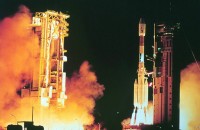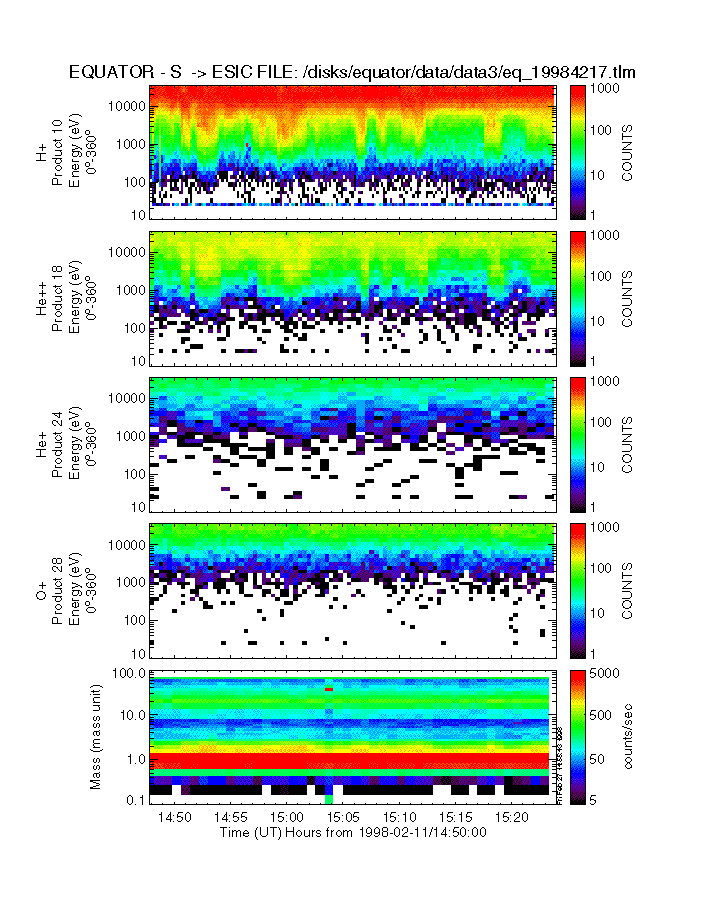


Last update: 04/03/98 10.34.07 CET
ESIC measures the 3D distribution functions of the major ion species, H, He+, He++, and O+. It consists of a retarding-potential analizer (RPA), followed by a toroidal energy-per-charge (E/q) analyzer with disk-shaped field of view, followed by a 20 kV post-acceleration into a time-of-flight (ToF) analysis section. Without RPA operation, the E/q range is 15V to 40 kV, otherwise it starts at essentially zero volts. To accommodate the large dynamic range in ion fluxes, the instrument has split the 360° FoV into two 180° sections whose sensitivities differ by a factor 100. Moments of the distributions of all 4 ion species are computed on board and are available every 4 spins, i.e., every 6s. The instrument is identical to the CODIF portion of the CIS instrument on CLUSTER. L. Kistler (UNH Durham, USA) is the LI.
ESIC will fly on board of the Equator-S mission. The emphasis of the mission will lie on the measurement of electric and magnetic fields, together with the imaging of highly resolved particles distribution within the plasma. Thus the structure and dynamics of the magnetopause, boundary between the solar wind and the magnetosphere, and especially processes like reconnection of magnetic fields in this region will be investigated. The effects of increased magnetic activity, so called magnetic storms and the associated plasma acceleration towards the Earth, the origin of electric polar flow systems, and their relation to the development of polar lights will be the center of interest on the nightside
ESIC image
In the IFSI insitute three Co-Investigators are part of the ESIC science team: Maria Bice Bavassano-Cattaneo, Pasquale Cerulli-Irelli and Andrea Maria Di Lellis.
IFSI is in charge of the ESIC on-board flight software and the instrument ground support equipment (GSE):
![]() The ESIC flight software has been designed to meet the scientific requirements of the mission even in limited transmission bit-rate allocation. The scientific return is represented by data products spanning from the momenta of the main ions species to the 3D distributions. The heavy on-board data handling of ESIC instrument necessary to adapt the measurements to the characteristics of the widely variable environment, has required a long testing activity to validate the calculations. A considerable amount of 3D simulations have been created and run into the instrument, to cross check the results of the on-board computations and the parallel off-line workstation calculations.
The ESIC flight software has been designed to meet the scientific requirements of the mission even in limited transmission bit-rate allocation. The scientific return is represented by data products spanning from the momenta of the main ions species to the 3D distributions. The heavy on-board data handling of ESIC instrument necessary to adapt the measurements to the characteristics of the widely variable environment, has required a long testing activity to validate the calculations. A considerable amount of 3D simulations have been created and run into the instrument, to cross check the results of the on-board computations and the parallel off-line workstation calculations.
![]() GSE supports live display of the instrument science and housekeeping activities on-board the Equator-S spacecraft intercepting and exctracting ESIC data from the main satellite broacasting. When connected off board directly to ESIC by the UNH PC card, the GSE emulates the spacecraft interface and activities. All telemetred data organized in packets can be displayed and monitored by highly friendly graphics diplays.
GSE supports live display of the instrument science and housekeeping activities on-board the Equator-S spacecraft intercepting and exctracting ESIC data from the main satellite broacasting. When connected off board directly to ESIC by the UNH PC card, the GSE emulates the spacecraft interface and activities. All telemetred data organized in packets can be displayed and monitored by highly friendly graphics diplays.
Last modified: Mon Dec 04/03/98 10:34:07 CET 1997